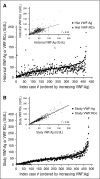Clinical and laboratory variability in a cohort of patients diagnosed with type 1 VWD in the United States
- PMID: 26862110
- PMCID: PMC4874228
- DOI: 10.1182/blood-2015-10-673681
Clinical and laboratory variability in a cohort of patients diagnosed with type 1 VWD in the United States
Abstract
von Willebrand disease (VWD) is the most common inherited bleeding disorder, and type 1 VWD is the most common VWD variant. Despite its frequency, diagnosis of type 1 VWD remains the subject of debate. In order to study the spectrum of type 1 VWD in the United States, the Zimmerman Program enrolled 482 subjects with a previous diagnosis of type 1 VWD without stringent laboratory diagnostic criteria. von Willebrand factor (VWF) laboratory testing and full-length VWF gene sequencing was performed for all index cases and healthy control subjects in a central laboratory. Bleeding phenotype was characterized using the International Society on Thrombosis and Haemostasis bleeding assessment tool. At study entry, 64% of subjects had VWF antigen (VWF:Ag) or VWF ristocetin cofactor activity below the lower limit of normal, whereas 36% had normal VWF levels. VWF sequence variations were most frequent in subjects with VWF:Ag <30 IU/dL (82%), whereas subjects with type 1 VWD and VWF:Ag ≥30 IU/dL had an intermediate frequency of variants (44%). Subjects whose VWF testing was normal at study entry had a similar rate of sequence variations as the healthy controls (14%). All subjects with severe type 1 VWD and VWF:Ag ≤5 IU/dL had an abnormal bleeding score (BS), but otherwise BS did not correlate with VWF:Ag. Subjects with a historical diagnosis of type 1 VWD had similar rates of abnormal BS compared with subjects with low VWF levels at study entry. Type 1 VWD in the United States is highly variable, and bleeding symptoms are frequent in this population.
© 2016 by The American Society of Hematology.
Figures





Comment in
-
Defining von Willebrand disease.Blood. 2016 May 19;127(20):2373-4. doi: 10.1182/blood-2016-03-700617. Blood. 2016. PMID: 27207323 No abstract available.
References
-
- Bowman M, Hopman WM, Rapson D, Lillicrap D, James P. The prevalence of symptomatic von Willebrand disease in primary care practice. J Thromb Haemost. 2010;8(1):213–216. - PubMed
-
- Rodeghiero F, Castaman G, Dini E. Epidemiological investigation of the prevalence of von Willebrand’s disease. Blood. 1987;69(2):454–459. - PubMed
-
- Werner EJ, Broxson EH, Tucker EL, Giroux DS, Shults J, Abshire TC. Prevalence of von Willebrand disease in children: a multiethnic study. J Pediatr. 1993;123(6):893–898. - PubMed
-
- Sadler JE. Von Willebrand disease type 1: a diagnosis in search of a disease. Blood. 2003;101(6):2089–2093. - PubMed
-
- Sadler JE. Slippery criteria for von Willebrand disease type 1. J Thromb Haemost. 2004;2(10):1720–1723. - PubMed
Publication types
MeSH terms
Substances
Grants and funding
LinkOut - more resources
Full Text Sources
Other Literature Sources
Medical
Miscellaneous

